Özlem Tuğfe Demir
Green One-Bit Quantized Precoding in Cell-Free Massive MIMO
Jul 30, 2025Abstract:Cell-free massive MIMO (multiple-input multiple-output) is expected to be one of the key technologies in sixth-generation (6G) and beyond wireless communications, offering enhanced spectral efficiency for cell-edge user equipments by employing joint transmission and reception with a large number of antennas distributed throughout the region. However, high-resolution RF chains associated with these antennas significantly increase power consumption. To address this issue, the use of low-resolution analog-to-digital and digital-to-analog converters (ADCs/DACs) has emerged as a promising approach to balance power efficiency and performance in massive MIMO networks. In this work, we propose a novel quantized precoding algorithm tailored for cell-free massive MIMO systems, where the proposed method dynamically deactivates unnecessary antennas based on the structure of each symbol vector, thereby enhancing energy efficiency. Simulation results demonstrate that our algorithm outperforms existing methods such as squared-infinity norm Douglas-Rachford splitting (SQUID) and regularized zero forcing (RZF), achieving superior performance while effectively reducing power consumption.
Control Signaling for Reconfigurable Intelligent Surfaces: How Many Bits are Needed?
Jun 04, 2025Abstract:Reconfigurable intelligent surfaces (RISs) can greatly improve the signal quality of future communication systems by reflecting transmitted signals toward the receiver. However, even when the base station (BS) has perfect channel knowledge and can compute the optimal RIS phase-shift configuration, implementing this configuration requires feedback signaling over a control channel from the BS to the RIS. This feedback must be kept minimal, as it is transmitted wirelessly every time the channel changes. In this paper, we examine how the feedback load, measured in bits, affects the performance of an RIS-aided system. Specifically, we investigate the trade-offs between codebook-based and element-wise feedback schemes, and how these influence the signal-to-noise ratio (SNR). We propose a novel quantization codebook tailored for line-of-sight (LoS) that guarantees a minimal SNR loss using a number of feedback bits that scale logarithmically with the number of RIS elements. We demonstrate the codebook's usefulness over Rician fading channels and how to extend it to handle a non-zero static path. Numerical simulations and analytical analysis are performed to quantify the performance degradation that results from a reduced feedback load, shedding light on how efficiently RIS configurations can be fed back in practical systems.
RIS-Assisted Survivable Fronthaul Design in Cell-Free Massive MIMO System
May 25, 2025Abstract:This paper investigates the application of reconfigurable intelligent surfaces (RISs) to improve fronthaul link survivability in cell-free massive MIMO (CF mMIMO) systems. To enhance the fronthaul survivability, two complementary mechanisms are considered. Firstly, RIS is set to provide reliable line-of-sight (LOS) connectivity and enhance the mmWave backup link. Secondly, a resource-sharing scheme that leverages redundant cable capacity through neighboring master access points (APs) to guarantee availability is considered. We formulate the redundant capacity minimization problem as a RIS-assisted multi-user MIMO rate control optimization problem, developing a novel solution that combines a modified weighted minimum mean square error (WMMSE) algorithm for precoding design with Riemannian gradient descent for RIS phase shift optimization. Our numerical evaluations show that RIS reduces the required redundant capacity by 65.6% compared to the no RIS case to reach a 99% survivability. The results show that the most substantial gains of RIS occur during complete outages of the direct disconnected master AP-CPU channel. These results demonstrate RIS's potential to significantly enhance fronthaul reliability while minimizing infrastructure costs in next-generation wireless networks.
Near-Field Beamfocusing, Localization, and Channel Estimation with Modular Linear Arrays
May 12, 2025Abstract:This paper investigates how near-field beamfocusing can be achieved using a modular linear array (MLA), composed of multiple widely spaced uniform linear arrays (ULAs). The MLA architecture extends the aperture length of a standard ULA without adding additional antennas, thereby enabling near-field beamfocusing without increasing processing complexity. Unlike conventional far-field beamforming, near-field beamfocusing enables simultaneous data transmission to multiple users at different distances in the same angular interval, offering significant multiplexing gains. We present a detailed mathematical analysis of the beamwidth and beamdepth achievable with the MLA and show that by appropriately selecting the number of antennas in each constituent ULA, ideal near-field beamfocusing can be realized. In addition, we propose a computationally efficient localization method that fuses estimates from each ULA, enabling efficient parametric channel estimation. Simulation results confirm the accuracy of the analytical expressions and that MLAs achieve near-field beamfocusing with a limited number of antennas, making them a promising solution for next-generation wireless systems.
Beyond Diagonal RIS Design for Parameter Estimation With and Without Eavesdropping
May 09, 2025Abstract:In this letter, we investigate the transmission of a complex-valued parameter vector from a transmitter to an intended receiver, considering both the presence and absence of an eavesdropper. The direct links from the transmitter to both the intended receiver and the eavesdropper are assumed to be blocked, and communications occur solely through cascaded channels facilitated by a beyond-diagonal reconfigurable intelligent surface (BD-RIS). While previous research has considered this system under conventional (diagonal) RIS assistance, we extend the setup to incorporate BD-RIS and quantify the resulting improvement in estimation performance at the intended receiver. This performance is measured by the trace of the Fisher information matrix (FIM), or equivalently, the average Fisher information, while simultaneously limiting the estimation capability of the eavesdropper. We propose solutions and algorithms for optimizing the BD-RIS response matrix and demonstrate their effectiveness. Numerical results reveal that the BD-RIS provides a significant enhancement in estimation quality compared to conventional diagonal RIS architectures.
Fair and Energy-Efficient Activation Control Mechanisms for Repeater-Assisted Massive MIMO
Apr 04, 2025Abstract:Massive multiple-input multiple-output (mMIMO) has been the core of 5G due to its ability to improve spectral efficiency and spatial multiplexing significantly; however, cell-edge users still experience performance degradation due to inter-cell interference and uneven signal distribution. While cell-free mMIMO (cfmMIMO) addresses this issue by providing uniform coverage through distributed antennas, it requires significantly more deployment cost due to the fronthaul and tight synchronization requirements. Alternatively, repeater-assisted massive MIMO (RA-MIMO) has recently been proposed to extend the coverage of cellular mMIMO by densely deploying low-cost single-antenna repeaters capable of amplifying and forwarding signals. In this work, we investigate amplification control for the repeaters for two different goals: (i) providing a fair performance among users, and (ii) reducing the extra energy consumption by the deployed repeaters. We propose a max-min amplification control algorithm using the convex-concave procedure for fairness and a joint sleep mode and amplification control algorithm for energy efficiency, comparing long- and short-term strategies. Numerical results show that RA-MIMO, with maximum amplification, improves signal-to-interference-plus-noise ratio (SINR) by over 20 dB compared to mMIMO and performs within 1 dB of cfmMIMO when deploying the same number of repeaters as access points in cfmMIMO. Additionally, our majority-rule-based long-term sleep mechanism reduces repeater power consumption by 70% while maintaining less than 1% spectral efficiency outage.
UAV-Based Cell-Free Massive MIMO: Joint Placement and Power Optimization under Fronthaul Capacity Limitations
Feb 07, 2025
Abstract:We consider a cell-free massive multiple-input multiple-output (mMIMO) network, where unmanned aerial vehicles (UAVs) equipped with multiple antennas serve as distributed UAV-access points (UAV-APs). These UAV-APs provide seamless coverage by jointly serving user equipments (UEs) with out predefined cell boundaries. However, high-capacity wireless networks face significant challenges due to fronthaul limitations in UAV-assisted architectures. This letter proposes a novel UAV-based cell-free mMIMO framework that leverages distributed UAV-APs to serve UEs while addressing the capacity constraints of wireless fronthaul links. We evaluate functional split Options 7.2 and 8 for the fronthaul links, aiming to maximize the minimum signal-to-interference-plus-noise ratio (SINR) among the UEs and minimize the power consumption by optimizing the transmit powers of UAV-APs and selectively activating them. Our analysis compares sub-6 GHz and millimeter wave (mmWave) bands for the fronthaul, showing that mmWave achieves superior SINR with lower power consumption, particularly under Option 8. Additionally, we determine the minimum fronthaul bandwidth required to activate a single UAV-AP under different split options.
Predictive Beamforming with Distributed MIMO
Jan 29, 2025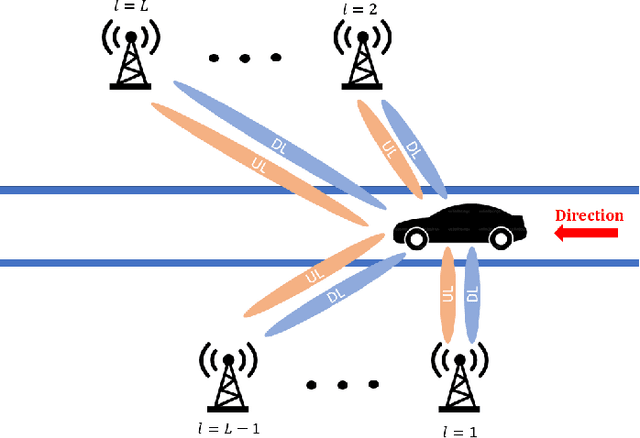
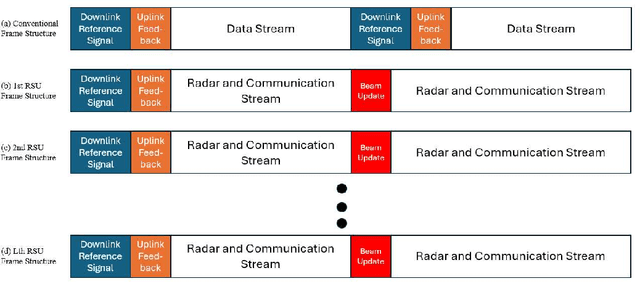

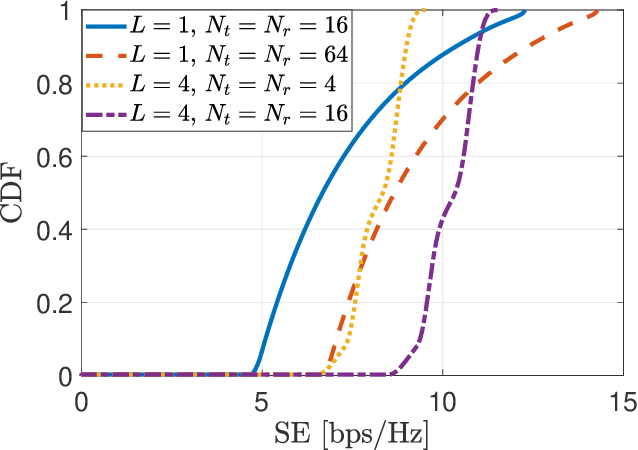
Abstract:In vehicle-to-everything (V2X) applications, roadside units (RSUs) can be tasked with both sensing and communication functions to enable sensing-assisted communications. Recent studies have demonstrated that distance, angle, and velocity information obtained through sensing can be leveraged to reduce the overhead associated with communication beam tracking. In this work, we extend this concept to scenarios involving multiple distributed RSUs and distributed MIMO (multiple-input multiple-output) systems. We derive the state evolution model, formulate the extended Kalman-filter equations, and implement predictive beamforming for distributed MIMO. Simulation results indicate that, when compared with a co-located massive MIMO antenna array, distributed antennas lead to more uniform and robust sensing performance, coverage, and data rates, while the vehicular user is in motion.
Energy-Efficient Cell-Free Massive MIMO with Wireless Fronthaul
Dec 03, 2024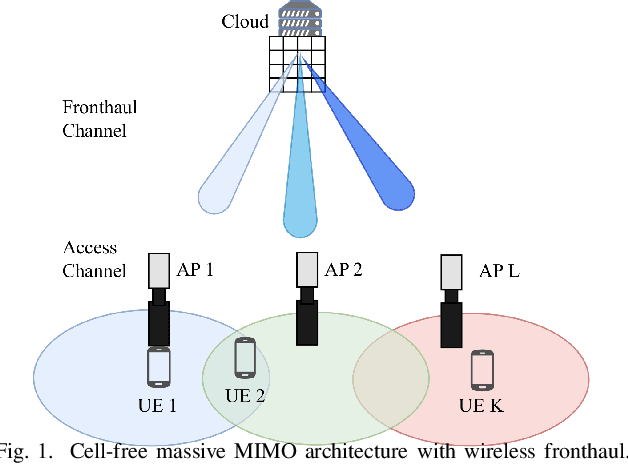
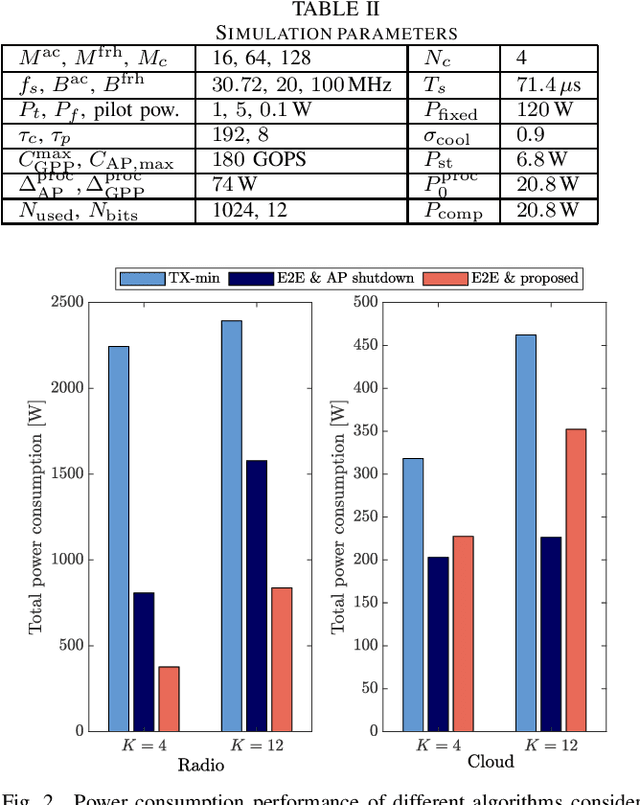
Abstract:Cell-free massive MIMO improves the fairness among the user equipments (UEs) in the network by distributing many cooperating access points (APs) around the region while connecting them to a centralized cloud-computing unit that coordinates joint transmission/reception. However, the fiber cable deployment for the fronthaul transport network and activating all available antennas at each AP lead to increased deployment cost and power consumption for fronthaul signaling and processing. To overcome these challenges, in this work, we consider wireless fronthaul connections and propose a joint antenna activation and power allocation algorithm to minimize the end-to-end (from radio to cloud) power while satisfying the quality-of-service requirements of the UEs under wireless fronthaul capacity limitations. The results demonstrate that the proposed methodology of deactivating antennas at each AP reduces the power consumption by 50% and 84% compared to the benchmarks based on shutting down APs and minimizing only the transmit power, respectively.
Capacity Maximization for MIMO Channels Assisted by Beyond-Diagonal RIS
Nov 27, 2024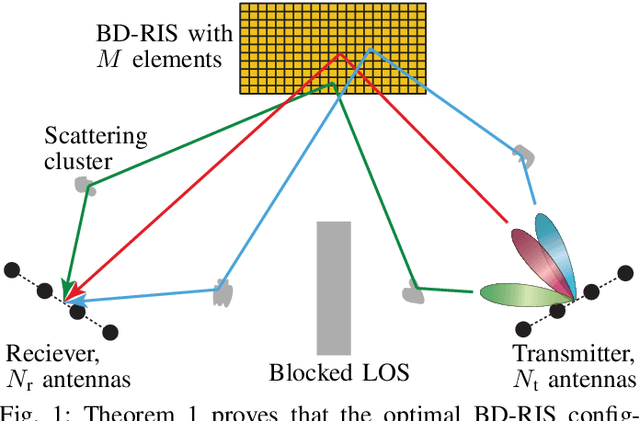
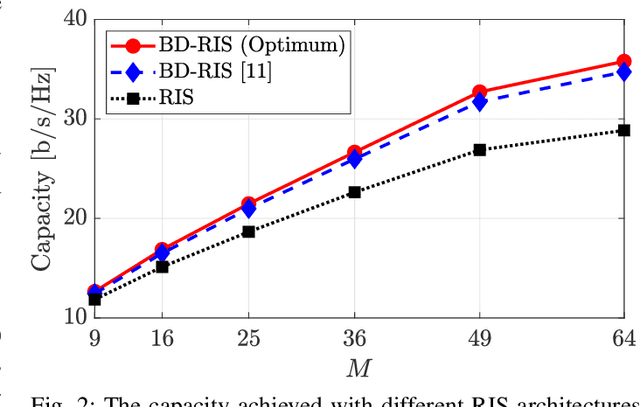
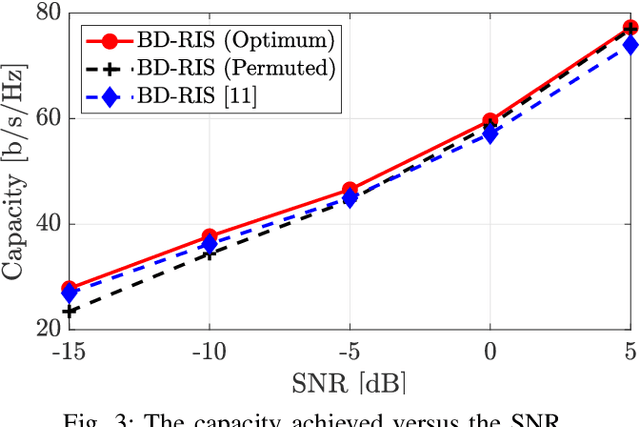
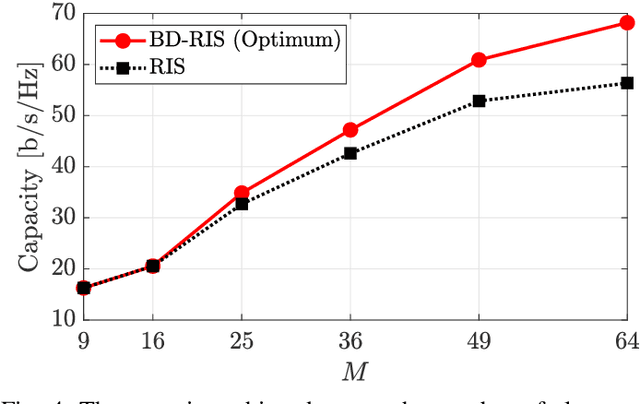
Abstract:Reconfigurable intelligent surfaces (RISs) can improve the capacity of wireless communication links by passively beamforming the impinging signals in desired directions. This feature has been demonstrated both analytically and experimentally for conventional RISs, consisting of independently reflecting elements. To further enhance reconfigurability, a new architecture called beyond-diagonal RIS (BD-RIS) has been proposed. It allows for controllable signal flows between RIS elements, resulting in a non-diagonal reflection matrix, unlike the conventional RIS architecture. Previous studies on BD-RIS-assisted communications have predominantly considered single-antenna transmitters/receivers. One recent work provides an iterative capacity-improving algorithm for multiple-input multiple-output (MIMO) setups but without providing geometrical insights. In this paper, we derive the first closed-form capacity-maximizing BD-RIS reflection matrix for a MIMO channel. We describe how this solution pairs together propagation paths, how it behaves when the signal-to-noise ratio is high, and what capacity is achievable with ideal semi-unitary channel matrices. The analytical results are corroborated numerically.
 Add to Chrome
Add to Chrome Add to Firefox
Add to Firefox Add to Edge
Add to Edge